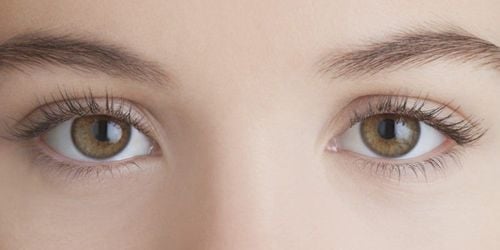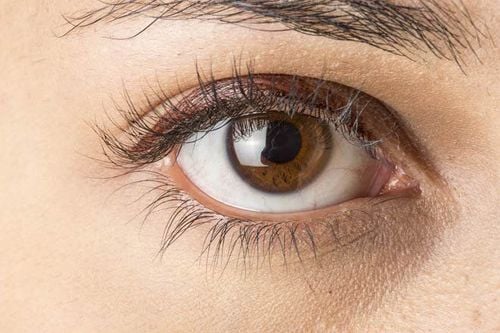This is an automatically translated article.
The article was professionally consulted by an eye doctor - Department of Medical Examination & Internal Medicine - Vinmec Hai Phong International General Hospital.Eye color depends on the amount of melanin pigment stored in the front layers of the iris. Melanocytes produce the pigment melanin, which is stored in intracellular compartments called melanosomes. Everyone has roughly the same number of melanocytes, but the number of melanocytes and the number of melanosomes in the melanocytes are different. So, what factors determine a person's eye color?
1. Do genetics determine eye color?
A person's eye color is a result of the iris pigment, which is a structure that surrounds a small black hole in the center of the eye (the pupil) and helps control how much light can enter the eye. The color of the iris continuously runs from light blue to dark brown. Most eye colors are classified into the following colors: Blue, green/light brown, or brown. Brown is the most popular eye color worldwide. Lighter eye colors, such as blues and greens, are found almost exclusively in people with European ancestry.
Eye color is determined by variations in a person's genes. Most of the genes that regulate eye color are involved in the production, transport, or storage of a pigment called melanin. Eye color is directly related to the quantity and quality of melanin in the eye, specifically in the anterior layers of the iris. People with brown eyes have a large amount of melanin pigment in the iris, while people with blue eyes have much less of this pigment.
A specific region on chromosome 15 plays an important role in eye color regulation. In this region, there are two genes located very close to each other: OCA2 and HERC2. The protein made from the OCA2 gene, called protein P, is involved in the maturation of melanosomes, which are cellular structures responsible for the production and storage of melanin. Therefore, protein P plays an important role in the quantity and quality of melanin present in the iris. Several common variants (polymorphisms) in the OCA2 gene reduce the amount of functional P protein produced. Less protein P means less melanin is present in the iris, resulting in blue eyes instead of brown in people with this gene polymorphism.

Màu mắt được xác định bởi các biến thể trong gen của một người
A nearby region of the HERC2 gene called intron 86 contains a piece of DNA that controls the activity (expression) of the OCA2 gene, turning it on or off as needed. At least one polymorphism in this region of the HERC2 gene has been shown to reduce the expression of OCA2, resulting in less melanin in the iris and lighter colored eyes.
Several other genes play a smaller role in determining eye color. Several of these genes are also associated with skin and hair color, including ASIP, IRF4, SLC24A4, SLC24A5, SLC45A2, TPCN2, TYR, and TYRP1. The effects of these genes can be combined with the OCA2 and HERC2 genes to produce a variety of eye colors.
Researchers used to think that eye color was determined by a single gene and followed a simple genetic model in which brown eyes were dominant to blue eyes. According to this model, it is believed that parents with blue eyes cannot have children with brown eyes. However, later studies showed that this model was too simple. Although uncommon, parents with blue eyes can have children with brown eyes. Inheritance of eye color is more complicated than originally thought because to determine eye color requires the involvement of many related genes. Although a child's eye color can often be predicted by the eye color of its parents and other relatives, genetic variations sometimes produce unpredictable results.
Several disorders affecting eye color have been discovered. Ocular albinism is characterized by severely reduced pigmentation of the iris, giving the eye a light color and causing serious vision problems. Several other conditions called cutaneous albinism affect the pigmentation of the skin and hair. People with this condition tend to have very light irises, fair skin, and white or light-colored hair. Both ocular and cutaneous albinism are caused by mutations in genes involved in the production and storage of the pigment melanin. Another condition called heterochromia is characterized by a person having two different eye colors. Iris dyspigmentation can be caused by a genetic mutation or a problem in eye development, or it can be acquired from disease or injury to the eye.

Bệnh bạch tạng khiến mắt có màu sáng và gây ra các vấn đề về thị lực
2. How do parents inherit eye color for their children?
Due to the number of genes involved in eye color, the inheritance pattern is complex. Although it is generally possible to guess a child's eye color by looking at the parent's eye color, polymorphism can arise, meaning that a child may also have an eye color that is not the same as the parent's.
A child's eye color depends on the pairing of genes passed down from each parent, which is thought to involve at least three pairs of genes. The two main pairs of genes that geneticists focus on are EYCL1 (also known as the gey gene) and EYCL3 (also known as the bey2 gene).
Different variations of genes are called alleles. The gey gene has one allele for green eyes and one allele for blue eyes. The bey2 gene has one allele for brown eyes and one allele for blue eyes. The allele for brown eyes is dominant and always completely dominant over the other 2 alleles and the allele for green eyes is always dominant over the allele for blue eyes, this is always a recessive trait. This means that parents have the same eye color, but their child can still create a different eye color.
For example, if two parents with brown eyes pass on a pair of blue alleles to their offspring, the child will be born with blue eyes. However, if one of the parents passes on a green allele, the child will have green eyes, and if the child has the brown allele, the child will have brown eyes, regardless of the other three alleles. what.

Màu mắt của một đứa trẻ phụ thuộc vào các gen được di truyền từ cha mẹ
3. Hereditary diseases affecting eye color
Several genetic conditions affect the eyes, with two examples being ocular albinism and cutaneous albinism. In the case of ocular albinism, the pigmentation of the iris is severely reduced resulting in a very bright eye color and vision problems. Dermatologic albinism also affects the pigmentation of the iris, including problems related to the skin and hair. People born with this condition tend to have very white skin, white or almost white hair, in addition to very bright irises. Both of these conditions are caused by mutations in genes involved in the production and storage of melanin.Please dial HOTLINE for more information or register for an appointment HERE. Download MyVinmec app to make appointments faster and to manage your bookings easily.
References: ghr.nlm.nih.gov, news-medical.net













